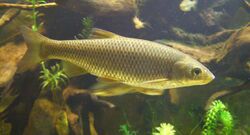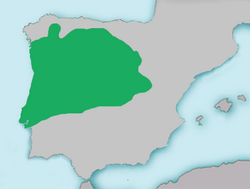Biology:Squalius carolitertii
| Northern Iberian chub | |
|---|---|

| |
| Scientific classification | |
| Domain: | Eukaryota |
| Kingdom: | Animalia |
| Phylum: | Chordata |
| Class: | Actinopterygii |
| Order: | Cypriniformes |
| Family: | Cyprinidae |
| Subfamily: | Leuciscinae |
| Genus: | Squalius |
| Species: | S. carolitertii
|
| Binomial name | |
| Squalius carolitertii (Doadrio, 1988)
| |

| |
| Range of the Northern Iberian chub | |
| Synonyms | |
|
Leuciscus carolitertii Doadrio, 1988 | |
Squalius carolitertii, the Northern Iberian chub, is a species of fresh-water fish in the family Cyprinidae. It is found in Portugal and Spain , and known there as the bordallo, escalo or gallego.
Its natural habitats are rivers and intermittent rivers. It is not considered threatened by the IUCN.
Distribution
Squalius carolitertii is a small endemic cyprinid inhabiting the rivers of the Iberian Peninsula across a large area, including the Douro, Mondego, Lima, Minho, and Lérez basins.[2] Recently several researchers have reported this species for the first time from the upper reaches of the Alberche River (a tributary of the Tagus basin in central Spain) and in the Oitavén River (a tributary of the Verdugo River in northwestern Spain).[3]
Diet
S. carolitertii is an omnivorous fish feeding predominantly on aquatic invertebrates, being nymphs of Baetis spp. The most abundant prey, although detritus, is an important food item.[4] Moreover, in S. carolitertii, as in many other fish species, there is normally a change in the diet composition during the life of the fish, and these age-related diet shifts occur at three different levels: (1) frequency of occurrence of detritus decreases with fish age; (2) prey selection varies with fish age; and (3) mean prey size increases as fish size increased.[5]
References
- ↑ Crivelli, A.J. (2006). "Squalius carolitertii". IUCN Red List of Threatened Species 2006: e.T61261A12455457. doi:10.2305/IUCN.UK.2006.RLTS.T61261A12455457.en. https://www.iucnredlist.org/species/61261/12455457. Retrieved 14 November 2021.
- ↑ Doadrio I., ed (2001). Atlas y libro rojo de los peces continentales de España. Ministerio de Medio Ambiente y Consejo Superior de Investigaciones Científicas, Madrid.
- ↑ Perea S.; Garzón P.; González J.L.; Almada V.C.; Pereira A.; Doadrio I. (2011). "New distribution data on Spanish autochthonous species of freshwater fish". Graellsia 67 (1): 91–102.
- ↑ Sánchez-Hernández J.; Cobo F. (2011). "Summer food resource partitioning between four sympatric fish species in Central Spain (River Tormes)". Folia Zoologica 60 (3): 189–202.
- ↑ Sánchez-Hernández J.; Cobo F. (2012). "Ontogenetic dietary shifts and food selection of endemic Squalius carolitertii (Actinopterygii: Cypriniformes: Cyprinidae) in River Tormes, Central Spain, in summer". Acta Ichthyologica et Piscatoria 42 (2): 101–111.
Further reading
Molecular Phylogenetics and Evolution 45 (2007) 981–996[1]
Wikidata ☰ Q513837 entry
 |
- ↑ "Reading the history of a hybrid fish complex from its molecular record". Molecular Phylogenetics and Evolution 45 (3): 981–996. December 2007. doi:10.1016/j.ympev.2007.05.011.


